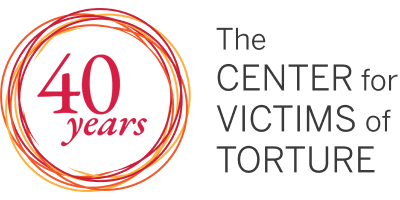Fatimah*, is a psychosocial counselor, CVT Ethiopia.
In refugee life, there are ups and downs.
I have lived as a refugee for eight years. Because of all we’ve experienced in the past, refugees have many challenges. We all have difficult backgrounds, and while our experiences are not all the same, there are many things we have in common. For one, here in the camp in northern Ethiopia, most of us are from Eritrea. Living here has many challenges, and there are many kinds of loss that we experience. Of course, we have lost our homes. Some have lost loved ones. But there are other kinds of loss, too. For one, because you are a refugee, you have to disclose about yourself. You lose your privacy when you lose your home. It affects you.
As a psychosocial counselor (PSC) at CVT, I help people who are coping with the traumatic experiences in their past. Before CVT, I worked with the women’s association and I got some computer training. I was interested in coming to CVT so I could help people. When I began working as a PSC, I went through training on CVT’s clinical manual – this guide gives very specific information about how to treat the clients in our 10-week group counseling cycle. I used this manual in my first training at CVT. I also use it in my approach to life.
As part of CVT, I appreciate that I can help people understand the healing work we do, and I can help them come to the center. Inside the camp, you see the value of the work. You feel you have value. Living here, I observe people. I see those who are staying by themselves, perhaps feeling isolated and alone. And I can also see those who are going outside and interacting with the community. I know how to identify people who may need help.
I’ve also observed things over the course of the 10-session group counseling cycle. During the first and second sessions, I sometimes notice clients whose hair is not combed and whose clothes are dirty. But after sessions five, six or seven, they change. They look well. They participate with each other in the sessions. We see the changes in them even after these few weeks. This is important to me in this work: we are here with them in their community. We are with them as they pass through these sessions and this healing journey.
Another reason I wanted to come to CVT and learn about the healing process is that I had a difficult upbringing. I wasn’t confident. I always felt that I couldn’t do it. But I saw how CVT approached people who need help, and I thought that learning about healing would help me.
And it did. Now I have more confidence. I feel better. I also don’t worry about some of the things that bothered me in the past. For example, today I care if my hair is not done, and I take care of myself. However, now I also don’t worry if my hair is not perfect one day. I have confidence with that. One day I was even joking around with my supervisor about her hair. We laughed about it. I would not have teased a supervisor and laughed like this in the past.
CVT has made a place for this to happen in my life. For me, CVT is il volante – the steering wheel. I wouldn’t have a life without CVT.
I expect to leave the camp one day, but I appreciate my life today. I have my children. In my work and my community, I get to talk with interesting people. I know my work makes a difference for people, and I know it is extremely serious for children and staff.
Hope is found in tomorrow. If you are living in today, you can experience tomorrow. This makes me hopeful.
*Name has been changed for safety and to protect confidentiality.
CVT’s work with Eritrean refugees in Ethiopia is funded by a grant from the U.S. State Department’s Bureau of Population, Refugees, and Migration.
